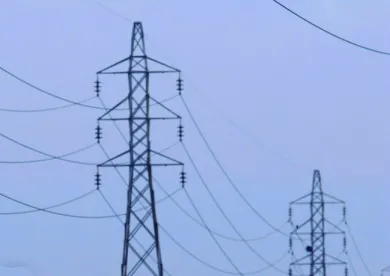On March 18, 2021, in response to a petition seeking clarification regarding the treatment of certain institutional investors for purposes of the Federal Energy Regulatory Commission’s (“FERC” or “Commission”) regulations, FERC issued an order addressing the scope of the obligation of public utilities selling at market-based rates (“MBR”) to identify and report their upstream owners and affiliates.[1] For purposes of the order, FERC defined utilities as including public utility operating companies, such as electric utility companies or transmitting utilities, and holding company systems containing such entities. While FERC’s order purports to affirm existing policy, the order provides guidance that public utilities should take into account when evaluating whether and how to report a particular ownership interest to FERC:
-
Institutional investors (such as Vanguard, Black Rock and State Street) that directly or indirectly own more than 10% percent or more of the publicly traded voting shares of a utility are affiliates of that utility and must be identified in the MBR filings and submissions.
-
Public utilities whose upstream owner’s shares are publicly traded are only required to report changes in the ownership shares held by their investors once the utility actually learns of a change in ownership that requires a modification to ownership information previously reported to FERC.
-
Public utilities that share a common upstream institutional investor that has been granted blanket FERC authorization to acquire public utility securities pursuant to Section 203(a)(2) of the Federal Power Act (“FPA”) will not be required to treat each other as affiliates for purposes of FERC’s MBR regulations. Because the conditions imposed on these investors prevent them from exercising day-to-day control over the utilities whose voting securities they acquire, FERC determined that utilities with a common upstream institutional investor are not under common control.
-
Public utilities must identify all upstream tax equity investors and other passive interest holders in their MBR filings.
In order to take into account the clarifications above, FERC concurrently issued an order[2] proposing to revise its guidelines regarding the reporting of upstream owners and affiliates for purposes of the new MBR relational database that FERC plans to implement later this year. To provide the Commission and interested parties additional time to consider the proposed changes, FERC also issued a notice delaying the timeframe for implementation of the relational database by three additional months, thereby giving MBR sellers until November 2, 2021 to submit their initial baseline filings. -
I. Background
When evaluating whether to grant a public utility authority to make sales at market-based rates, FERC will consider whether the public utility and its affiliates have market power in a given geographic market as a result of their ownership and control over generation facilities, transmission facilities, and inputs to electric power production. For purpose of FERC’s MBR regulations, the definition of “affiliate” includes any person that “directly or indirectly owns, controls, or holds with power to vote, [10% or more] of the outstanding voting securities of the specified company” as well as “any person that is under common control” with the public utility.[3]
In recent years, FERC has required MBR sellers to submit asset appendices listing the assets owned and operated by the seller and its affiliates. In Order No. 860, however, the Commission revised its regulations to require MBR sellers to submit information regarding their assets and affiliates into a new “relational database” that will be established and maintained by the Commission.[4] More specifically, Order No. 860 required each MBR seller to identify its “ultimate upstream affiliate,” which is defined as “the furthest upstream affiliate(s) in the ownership chain.” Once a seller identifies its ultimate upstream affiliate(s), FERC’s database will then create an asset appendix and organizational chart associate the seller with any other public utility with the same ultimate upstream affiliate(s). That database is not yet currently operational and FERC is expected to implement the database later this year, as discussed further below. -
II. Order Denying Petition Respecting Institutional Investors and Passive Owners
In October 2020, NextEra Energy, Inc. and a number of other utilities (the “Petitioners”) filed a petition asking the Commission to issue an order addressing the treatment of institutional financial investors that have been granted blanket authorization under FPA Section 203(a)(2) to acquire up to 20% of the publicly traded voting securities of utilities in light of the reporting requirements adopted in Order No. 860. Over the past decade, FERC has granted various financial institutions blanket authorization pursuant to Section 203(a)(2) of the FPA—which requires prior FERC authorization for certain transactions involving the acquisition of utility securities —to acquire up to 20% of the publicly traded voting securities of a utility without seeking separate authorization for each individual transaction. These authorizations include typical conditions that the investor must comply with to prevent it from exercising control over the day-to-day operation of public utility operating subsidiaries, including MBR sellers. Because the institutional investors that have been granted such blanket authorization have acquired voting securities in significant numbers of utilities, the Petitioners expressed concern that a strict application of the Commission’s determinations in Order No. 860 could result in public utilities being treated as affiliates merely because they have a common upstream shareholder. The Petitioners therefore requested that the Commission issue an order making the following determinations:
-
First, the Petitioners requested that the Commission find that no affiliation arises under Section 205 when institutional investors acquire up to 20% of the voting securities of a utility pursuant to a Section 203(a)(2) blanket authorization.
-
Second, the Petitioners requested that the Commission determine that public utilities remain free to conclude, without obtaining case-specific Commission rulings, that certain securities do not convey control and are passive (i.e., do not result in an affiliate relationship). The Petitions argued that requiring public utilities to submit a change in status filing to report the acquisition of a passive ownership interest would be inconsistent with FERC’s longstanding policy allowing utilities to make their own determination regarding whether a particular interest is passive or constitutes a voting interest.
In its March 18th Order, the Commission denied the petition and affirmed that institutional investors that directly or indirectly own 10% or more of the publicly traded shares of a utility are affiliates of that utility for the purpose of Section 205, even if they purchased their interest pursuant to a blanket authorization. While the Commission acknowledged that it had imposed limitations on the ability of such investors to exercise control as a condition of granting FPA Section 203(a)(2) blanket authorization, the Commission noted that the definition of affiliate extends to any person that “owns, controls, or holds with power to vote” 10% or more of the voting securities of a public utility. According to the Commission, granting the petition would have effectively narrowed the definition of affiliate to focus only on control, thereby eliminating affiliation based on ownership or holding of voting securities in a manner inconsistent with the plain language of FERC’s regulations.
The Commission also rejected the petitioners’ argument that the rights held by institutional investors purchasing pursuant to a blanket authorization are akin to the types of non-voting, passive interests that FERC has found do not create an affiliate relationship. The Commission acknowledged that it previously has determined that holding a non-voting interest that confers on the holder only limited veto and consent rights necessary to protect the value of the investment is passive and does not result in affiliation. The Commission noted, however, that institutional investors that have acquired ownership interests pursuant to a blanket authorization have the ability to vote in the direction and management affairs of the company; as a result, the securities held by these investors constitute voting securities notwithstanding that the day-to-day control of the investor may be limited.
Significantly, although the Commission rejected the Petitioners’ arguments that institutional investors with FPA Section 203(a)(2) blanket authorization should not be considered to be affiliates of the utility, the Commission granted the Petitioners limited relief by finding that public utilities that share a common institutional investor pursuant to a Section 203(a)(2) blanket authorization should not be deemed to be affiliated with each other. Because the conditions imposed on institutional investors prevent them from exercising control over the day-to-day affairs of utilities, the Commission reasoned that there was no basis for finding that utilities that are owned by a common institutional investor are subject to common control. The Commission explained that this clarification was intended to ensure that a utility that has an upstream institutional investor will not need to associate itself with other utilities owned by the investor in FERC’s new relational database.Responding to concerns that public utilities may have difficulty timely reporting changes in the ownership interests held by institutional investors that are acquired through public trading, the Commission found that MBR sellers will only be required to update their affiliate information in the new relational database if the change in circumstances is known and within the control of the reporting public utility. The Commission explained, for instance, that providing updated ownership information based on the quarterly reports filed by institutional investors with FERC as a condition to the FPA Section 203(a)(2) authorizations would be appropriate if that is the means through which the MBR seller received knowledge of changes in ownership.
With respect to passive ownership interests, the Commission denied the Petitioners’ request that the Commission find that passive ownership interests do not need to be identified in the narratives of MBR filings. Although the Commission acknowledged that following Order No. 860 sellers are only required to affirm that a particular interest is passive, the Commission reaffirmed its prior statements that a seller must identify all owners, including passive owners, in their market-based rate filings.III. Order Proposing Changes To Order No. 860 Reporting Requirement and Delaying Implementation
Given the determinations set out above, the Commission separately issued an order proposing changes to FERC’s data dictionary for its new relational database to allow MBR sellers to report upstream institutional investors without resulting in all public utilities that are held by common investors being treated as affiliates. Specifically, the Commission proposes to revise the MBR relational database data dictionary to require MBR sellers reporting institutional investors that have purchased securities pursuant to a blanket authorization to: (1) identify the docket number where authorization was granted; and (2) identify the upstream affiliates whose securities were acquired pursuant to the blanket authorization. FERC explains that this reporting requirement will ensure that all upstream owners are identified while preventing the database from connecting public utilities through institutional investors with blanket authorization when generating asset appendices. Comments on the Commission’s proposal are due within 60 days of publication of the proposal in the Federal Register.
Given this proposed change to the relational database, FERC also issued a notice delaying the implementation date of its relational database. The database was scheduled to come online April 1, 2021, the same day Order 860 is set to become effective. That implementation date has been pushed to July 1, 2021, with initial filings due by November 2, 2021. The table below provides a comparison of the prior deadlines and the new deadlines established by the Commission as a result of last week’s orders.
|
Implementation Steps |
Previous Timeline |
New Timeline |
|
MBR Database Test Environment Availability |
Through March 31, 2021 |
Through June 30, 2021 |
|
MBR Database Online for Baseline Submissions |
April 1, 2021 |
July 1, 2021 |
|
Baseline Submission Deadline |
August 2, 2021 |
November 2, 2021 |
|
First Change in Status Deadline |
August 31, 2021 |
November 30, 2021 |
[1] NextEra Energy, Inc., et al., 174 FERC ¶ 61,213 (2021).
[2] Data Collection for Analytics and Surveillance and Market-Based Rate Purposes, 174 FERC ¶ 61,214 (2021).
[3] 18 C.F.R. § 35.36(a)(9).
[4] Data Collection for Analytics and Surveillance and Market-Based Rate Purposes, Order No. 860, 168 FERC ¶ 61,039 (2019), order on reh’g, Order No. 860-A, 170 FERC ¶ 61,129 (2020).



 />i
/>i
